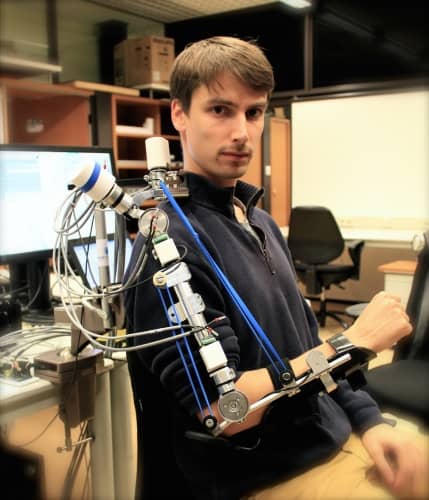A video describing the research can be found at this address:
Dubbed A-Gear, the robotic arm has been developed in the Netherlands by researchers from the University of Twente's MIRA research centre, the VU University Medical Center Amsterdam (VUmc), Delft University of Technology (TU Delft), and Radboud University Medical Centre.
According to the University of Twente, the team has finished the first prototype for a discreet, body-connected support aid that can be worn under the clothing and support independent operation of the arm during daily activities.
Duchenne muscular dystrophy is a rare degenerative condition affecting the muscles of young boys who eventually lose the ability to use their arms, along with other symptoms of the condition. Medicines can slow the progress of the disease and increase the life expectancy of boys with Duchenne, thereby expediting the need to preserve arm function.
Support aids can recapture the loss of muscle function in the arms, but they do not compensate for the entire loss of function and can result in stigmatisation.
Over the past four years, the researchers have been working on two arm supports: a passive arm support - controlled by the user, without motors - and an active arm support - powered by motors that are controlled by the user.
The active arm support is controlled by electrical (EMG) muscle signals or minimum muscle strength from the arm, which makes movement as intuitive and natural as possible.

In order to assess their design, the researchers compared the arm functionality of boys with Duchenne with and without A-Gear arm support.
"During the research, there were a number of participants who had been unable to independently move their arms for between three and five years and they were able to complete the tests set out in the tasks. The freedom of movement and the functionality of the arm increased when the subjects used the prototype. In addition, the movements required less energy," said Joan Lobo-Prat, researcher at the MIRA research centre for Biomedical Technology and Technical Medicine.
During their research the team also sought insights into the development of arm function in boys and men with Duchenne muscular dystrophy through the Duchenne Dynamic Arm Study (DDAS).
By measuring the arm function of patients of different ages, they were able to obtain an impression of how the arm function changes over the course of the illness and accordingly, how to adjust the arm support over time.
The results of the A-Gear project are said to have provided new insights into the appearance of support aids and a review is being carried out to ascertain the next steps to convert the prototype into a useful product.
The A-Gear project is an initiative of Flextension, which was initiated by the Duchenne Parent Project. Flextension started in 2007 as a result of questions from the Duchenne community about what engineering and technology could do to improve the quality of life for boys with Duchenne.




Report highlights significant impact of manufacturing on UK economy
Note to Evil Villain/Dave 2020. Thatcher was PM for _11_ years, from 1979 to 1990 so no one under the age of 34 was even born when she left office....